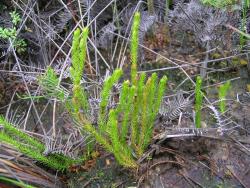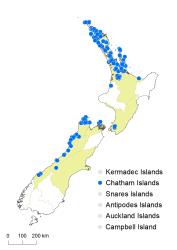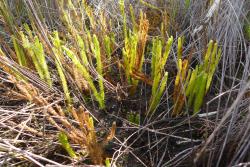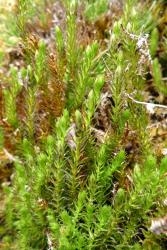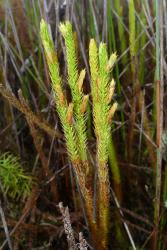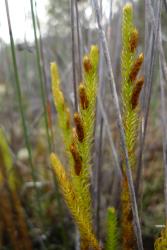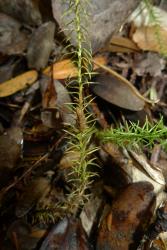- ≡ Lycopodium laterale R.Br., Prodr. Fl. Nov. Holland. 165 (1810)
- ≡ Lepidotis lateralis (R.Br.) Rothm., Feddes Repert. Spec. Nov. Regni Veg. 54: 67 (1944)
- ≡ Lateristachys lateralis (R.Br.) Holub, Folia Geobot. Phytotax. 18: 441 (1983)
- = Lycopodium consimile Colenso, Trans. & Proc. New Zealand Inst. 16: 348 (1884) – as L. consimilis
Horizontal stems dichotomously branching, subterranean, 0.6–3.0 mm diameter, bearing roots at intervals; leaves absent or widely spaced, spreading, narrowly ovate, adnate. Aerial stems erect or scrambling upwards, dichotomously branching 1–4 times, glabrous; longest fertile aerial branching system 50–700 mm tall, 35–200 mm wide. Sterile leaves monomorphic, spirally arranged, similar throughout, spreading and often reflexed, linear to narrowly triangular, apices acuminate, margins entire or minutely ciliate at apex, bases adnate, 3.5–9 mm long, 0.3–0.9 mm wide, dull green or tinged red-brown. Sporophylls appressed when young, spreading at maturity, ovate to broadly ovate, apices acuminate, margins ciliate, bases adnate, 1.8–3.0 mm long, 1.2–2.0 mm wide, aggregated into strobili. Strobili solitary, lateral or rarely terminal on aerial stems, erect, sessile or on short leafy lateral branches up to 7 mm long, yellow-brown when young, tan-brown or chocolate-brown at maturity, 5–30 mm long, 2.5–5.0 mm wide.
Lycopodiella lateralis is distinguished from all other species of Lycopodiaceae in New Zealand, except L. diffusa, by its strobili being borne laterally on the aerial stems, and in being characteristically chocolate-brown at maturity. The aerial stems grow erect, or scramble upwards through other vegetation, branching dichotomously up to four times, while the horizontal stems are subterranean. In L. diffusa, the aerial stems are prostrate, with only the ends of the branches upturned, and are generally much shorter than in L. lateralis (25–170 mm, cf. 50–700 mm tall). The leaves of L. lateralis are generally spreading or reflexed, and slightly longer and narrower than in L. diffusa (3.5–9.0 mm long, 0.3–0.9 mm wide; cf. 2.5–6.0 mm long, 0.5–1.1 mm wide).
North Island: Northland, Auckland, Volcanic Plateau, Southern North Island.
South Island: Western Nelson, Sounds-Nelson, Westland, Canterbury.
Chatham Islands.
Altitudinal range: 0–850 m.
Lycopodiella lateralis grows best in lowland areas of the North Island, from Te Paki south to the Herangi Range and Bay of Plenty, growing from near sea level to 600 m, but reaching 750 to 850 m in Coromandel and the Kaimai Range. There are also localised populations in the southern Tararua and Rimutaka Ranges, but the species is apparently absent from much of Taranaki, the central North Island and the east coast. In the South Island it extends from north-west Nelson and the Marlborough Sounds to the Cascade Valley in southern Westland. It is confined to lowland areas from near sea level to 250 m, but reaches 500 m on the Stockton Plateau. It also reaches the Chatham Islands.
Also Australia (South Australia, Queensland, New South Wales, Victoria, Tasmania) and New Caledonia.
Lycopodiella lateralis grows on gumland, serpentine, pākihi, sand and other poor soils, in Sphagnum bog, on peat or swampy ground with Gleichenia, Juncus and Empodisma spp., and sometimes in ditches, on damp rock faces or clay banks. It occurs in tussock, under mānuka, kānuka, Dracophyllum and low broadleaved scrub, and sometimes extends into podocarp or broadleaved forest.
2n = c. 122 (de Lange et al. 2004).
Burnard et al. (2016) detected several haplotypes in Lycopodiella diffusa and L. lateralis but they did not correspond to the two different morphologies. Three samples with L. lateralis morphology shared the haplotype found in L. diffusa. Whether this is evidence of hybridisation between the two taxa or a result of ancestral polymorphism is unclear. Their status needs further investigation.



